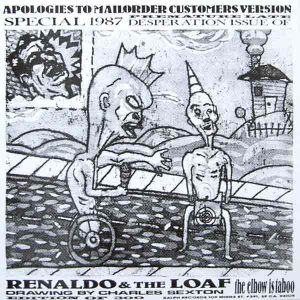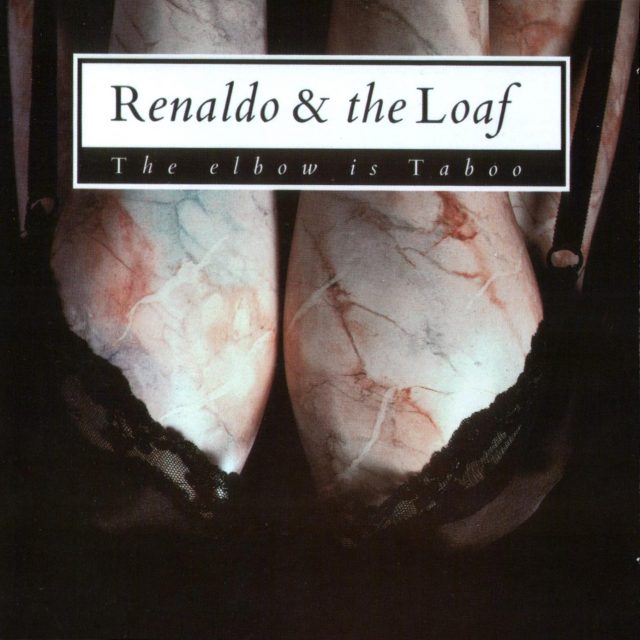Original Tracklist
- A Street Called Straight
- Boule!
- The Elbow is Taboo
- Hambu Hodo
- Dance for Somnambulists
- Here’s to the Oblong Boys
- The Bread Song
- Critical/Dance
- Extracting the Re-Re
Releases
- 1987 LP: Ralph Records RR87081 (US)
- 1987 LP: Some Bizz Are .rD5 (UK)
- 1987 LP: Torso 33049 (Holland)
- 1993 CD: T. E. C. Tones 93782
- 1997 CD: Some Bizarre SBZ036CD
- 2016 CD: Klanggalerie gg213 (2CD, with bonus tracks, “Elbonus”)
- 2019 LP: Editions Mego .rD7 (2LP with “Elbonus” bonus tracks; the first 300 copies also contained a limited 7” disc featuring Hambu Hodo Live and a remix, Hambu Hoedown)
History
Dave, “There were a group of us sitting in a pub one Saturday night talking and somehow the phrase the elbow is taboo came into the conversation, either I or Brian actually said it and we looked at one another and said, ‘that would make a good song title.’ It was only later that we decided to make that the name for the album as well.
“I can’t say that recording was hard, it was certainly different, and I suppose it took a long time. The big change was recording venue and technology. The surgery was no more, we now had a studio at Brian’s flat and we’d also moved on to an 8-track tape recorder and a proper mixer. All of that was made possible through the money we received from Title in Limbo…I’d always had the luxury of being able to experiment whenever I wanted to, with the equipment in my bedroom and this was no longer possible. Having the equipment at Brian’s permanently set up in a room that was used solely as a studio was the logical thing to do. But it did have a big effect on my input. I never felt as comfortable with the new equipment using as the old four-track. We were using a crude sampler for the first time as well, plus a drum machine, so the sound changed as well.”
Brian, “On Elbow we tried some new equipment, a Roland TR-606 drum machine and a digital delay unit by Korg SDD-1000. This featured a limited sample facility, up to 2 seconds mono!!! Also it was not transposable and could only be triggered by a pulse. We used the TR-606 to do this as well as our Casio keyboard. The clarinet orchestra at the end of Hambu Hodo was played using this sample method, each different note had to be triggered independently and spaces left for other notes when playing it…sounds complicated, it was!
“Our sound would have developed further using samplers but it was to be our last album. It took over 2 years to record (1984-6) but then it hung around and was not released until 1987. Our UK record company, Some Bizarre, made sure we got full control over the product, the mastering was on time but the cover photos produced by Some Bizarre were not what we wanted and we took new photos ourselves. It seemed to take ages before the finished article was available and it took a lot of our energy and time. With Ralph we usually got on with new stuff when master tapes were sent off to them, we didn’t have to do much more.
“By the time Elbow was finally completed, I think it’s fair to say we were tired of it. Our momentum was lost. Dave and I found it tricky to get going but had started to discuss ideas for what could happen next…
Dave, “We did record a few other things afterwards. There was a piece we did for a Ralph sampler called ‘Haul on the Bowline’ – a reworking of a traditional sea shanty. I think we’d just run out of steam.”
This was to be Renaldo & The Loaf’s last album for nearly 30 years.
Listen
Trivia
 The Elbow Is Taboo Desperation Issue
The Elbow Is Taboo Desperation Issue
This interim release was for Ralph mail order customers who has been kept waiting due to a delay in cover printing parts arriving from England -not RatL’s fault by the way. The disc contents and centre labels are no different to the final release.
Clear vinyl edition of 300 in plain white cover with applied special artwork.
Waldo said: “Bite the Wax Tadpole”.
Dave explains this odd quote from the liner notes: “I was reading a copy of Readers Digest at coffee break one day and came across this amusing piece of information. When Coca-Cola first went on sale in China the marketing department looked for some Chinese characters that sounded phonetically like Coca-Cola. When they translated these characters into English they discovered that they meant ‘bite the wax tadpole’.”
